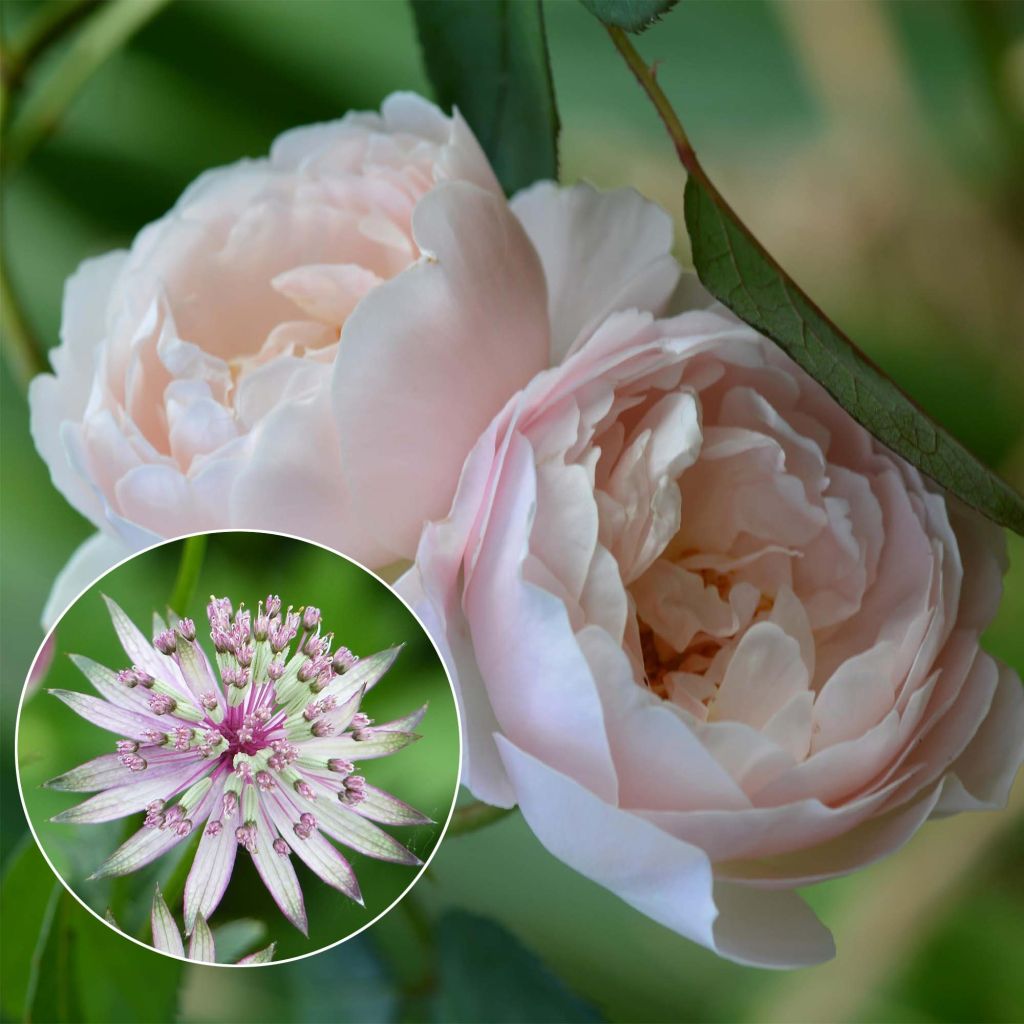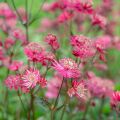

Fatal Liaison Duo
Fatal Liaison Duo
Rosa, Astrantia Astrantia major Ruby Star®, Rosa Desdemona® (Auskindling)
This plant carries a 12 months recovery warranty
More information
We guarantee the quality of our plants for a full growing cycle, and will replace at our expense any plant that fails to recover under normal climatic and planting conditions.
From €5.90 for pickup delivery and €6.90 for home delivery
Express home delivery from €8.90.
Delivery to Corse prohibited: UE law prohibits the import of this plant from mainland France to Corse as part of the fight against Xylella fastidiosa. Please accept our sincere apologies.
More information
Does this plant fit my garden?
Set up your Plantfit profile →
Collection items (4 plants)
Description
The collection consists of:
- x 3 Ruby Star Astrantia : featuring red flowers, the darkest ever seen in astrantias, this variety is also exceptional for its flowering period, from May to October. This perennial forms a clump of 60cm (24in) in height when in bloom, and 30cm (1 and 12in) in width. The decorative foliage consists of palmate leaves, with 5 deep lobes, lanceolate, toothed, green and strongly veined. Accustomed to cottage gardens, it is an easy-to-grow native plant in any good garden soil that remains cool. It is also a good flower for dry or fresh bouquets.
- x 1 Desdemona rose - Auskindling: a bush of 1.25m (4ft) by 1m (3ft), introduced by David Austin in 2015. Vigorous, it has an ample and airy growth habit, gradually bending outwards at its top. Its round and perfect 10cm (4in) diameter flowers, gathered in fragrant bouquets, bloom from May to June until the first frost. It is a very healthy rose, resistant to diseases, and of beautiful vigour. Its foliage is bright green with a slight purple tinge, shiny on the upper side and cottony on the underside. Its stems are virtually thornless.
A very beautiful combination between this rose that embodies purity and encourages meditation, and the astrantia from cottage gardens adorned with red flowers crafted like jewels. A meeting that brings the garden into a world of legends and passion. Enhance this duo with some annual plants with light flowering, such as white nigellas, Bunny Tails and 'Mother of Pearl' poppies, for example.
Report an error about the product description
Flowering
Foliage
Plant habit
Botanical data
Rosa, Astrantia
Astrantia major Ruby Star®, Rosa Desdemona® (Auskindling)
Cultivar or hybrid
Planting and care
Astrantia major Star Ruby grows in ordinary, moist and uncompacted soil, in sunny, partially shaded or even shady locations in warm climates. It requires little maintenance. Cut back the unsightly foliage before winter and remove faded flowers to encourage new flowering. It self-seeds very easily. Its only known pests are slugs and snails.
This perennial should be planted in spring or autumn, at a rate of 5 plants/m2. To plant your young plant, work the soil to a depth of 20cm (8in), crumbling the soil and adding a base amendment such as bonemeal at the bottom of the planting hole. Position your plant, removing it from its pot, and covering the top of the root ball with 3cm (1in) of soil, backfill and water thoroughly to eliminate air pockets. During dry weather, water regularly for a few weeks to facilitate root growth. During wet weather, keep slugs away, as they are a threat to young plantings. How? By using wood ash or by making traps with beer.
Plant your English Rose Desdemona in a sunny or lightly shaded location. English roses are tolerant but do not like excessive limestone. They will adapt to any garden as long as the soil is well-worked and sufficiently rich. To plant your rose, work the soil, crumbling it well, and add an amendment, such as bonemeal, at the bottom of the planting hole. Water thoroughly after planting to eliminate air pockets. Water regularly for a few weeks to facilitate root growth. Pruning English roses is essential for flowering.
Planting period
Intended location
Care
This item has not been reviewed yet - be the first to leave a review about it.
Haven't found what you were looking for?
Hardiness is the lowest winter temperature a plant can endure without suffering serious damage or even dying. However, hardiness is affected by location (a sheltered area, such as a patio), protection (winter cover) and soil type (hardiness is improved by well-drained soil).

Photo Sharing Terms & Conditions
In order to encourage gardeners to interact and share their experiences, Promesse de fleurs offers various media enabling content to be uploaded onto its Site - in particular via the ‘Photo sharing’ module.
The User agrees to refrain from:
- Posting any content that is illegal, prejudicial, insulting, racist, inciteful to hatred, revisionist, contrary to public decency, that infringes on privacy or on the privacy rights of third parties, in particular the publicity rights of persons and goods, intellectual property rights, or the right to privacy.
- Submitting content on behalf of a third party;
- Impersonate the identity of a third party and/or publish any personal information about a third party;
In general, the User undertakes to refrain from any unethical behaviour.
All Content (in particular text, comments, files, images, photos, videos, creative works, etc.), which may be subject to property or intellectual property rights, image or other private rights, shall remain the property of the User, subject to the limited rights granted by the terms of the licence granted by Promesse de fleurs as stated below. Users are at liberty to publish or not to publish such Content on the Site, notably via the ‘Photo Sharing’ facility, and accept that this Content shall be made public and freely accessible, notably on the Internet.
Users further acknowledge, undertake to have ,and guarantee that they hold all necessary rights and permissions to publish such material on the Site, in particular with regard to the legislation in force pertaining to any privacy, property, intellectual property, image, or contractual rights, or rights of any other nature. By publishing such Content on the Site, Users acknowledge accepting full liability as publishers of the Content within the meaning of the law, and grant Promesse de fleurs, free of charge, an inclusive, worldwide licence for the said Content for the entire duration of its publication, including all reproduction, representation, up/downloading, displaying, performing, transmission, and storage rights.
Users also grant permission for their name to be linked to the Content and accept that this link may not always be made available.
By engaging in posting material, Users consent to their Content becoming automatically accessible on the Internet, in particular on other sites and/or blogs and/or web pages of the Promesse de fleurs site, including in particular social pages and the Promesse de fleurs catalogue.
Users may secure the removal of entrusted content free of charge by issuing a simple request via our contact form.
The flowering period indicated on our website applies to countries and regions located in USDA zone 8 (France, the United Kingdom, Ireland, the Netherlands, etc.)
It will vary according to where you live:
- In zones 9 to 10 (Italy, Spain, Greece, etc.), flowering will occur about 2 to 4 weeks earlier.
- In zones 6 to 7 (Germany, Poland, Slovenia, and lower mountainous regions), flowering will be delayed by 2 to 3 weeks.
- In zone 5 (Central Europe, Scandinavia), blooming will be delayed by 3 to 5 weeks.
In temperate climates, pruning of spring-flowering shrubs (forsythia, spireas, etc.) should be done just after flowering.
Pruning of summer-flowering shrubs (Indian Lilac, Perovskia, etc.) can be done in winter or spring.
In cold regions as well as with frost-sensitive plants, avoid pruning too early when severe frosts may still occur.
The planting period indicated on our website applies to countries and regions located in USDA zone 8 (France, United Kingdom, Ireland, Netherlands).
It will vary according to where you live:
- In Mediterranean zones (Marseille, Madrid, Milan, etc.), autumn and winter are the best planting periods.
- In continental zones (Strasbourg, Munich, Vienna, etc.), delay planting by 2 to 3 weeks in spring and bring it forward by 2 to 4 weeks in autumn.
- In mountainous regions (the Alps, Pyrenees, Carpathians, etc.), it is best to plant in late spring (May-June) or late summer (August-September).
The harvesting period indicated on our website applies to countries and regions in USDA zone 8 (France, England, Ireland, the Netherlands).
In colder areas (Scandinavia, Poland, Austria...) fruit and vegetable harvests are likely to be delayed by 3-4 weeks.
In warmer areas (Italy, Spain, Greece, etc.), harvesting will probably take place earlier, depending on weather conditions.
The sowing periods indicated on our website apply to countries and regions within USDA Zone 8 (France, UK, Ireland, Netherlands).
In colder areas (Scandinavia, Poland, Austria...), delay any outdoor sowing by 3-4 weeks, or sow under glass.
In warmer climes (Italy, Spain, Greece, etc.), bring outdoor sowing forward by a few weeks.






































